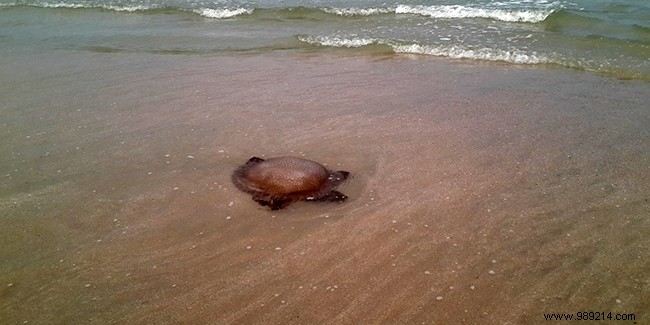
Swimming in the sea is on the program of your summer holidays. But these may not go as you expected if you get stung by jellyfish that have washed up on the beaches. Their bites will cause you strong burning sensations and pain. In this case, what should be done and what should be avoided?
In general, jellyfish stings are not serious. The instant a jellyfish makes contact with the skin, it deposits hundreds of stinging cells there with a strong pressure like an electric shock. Instantly, you feel a burning sensation followed by pain and itching. A red lesion of about 4 cm will appear on the bitten area with the presence of vesicles filled with venom. The lesion can last ten days or even a month, but in most cases it disappears on its own. Some people are allergic to jellyfish stings, which may manifest as difficulty breathing, vomiting or loss of consciousness.
As soon as you feel the symptoms of a jellyfish sting, get out of the water immediately to avoid drowning if you panic. What you need to do to remove the fragments of tentacles attached to your skin is to rinse the bitten part with sea water or saline solution. Then sprinkle with wet sand and let dry. Then, gently remove the sand with a thin, rigid object to remove the poisonous tentacles that have remained attached to your skin. Rinse again with sea water for at least 30 seconds. The use of tweezers is also recommended to remove the stinging filaments. Another method is to use a heat source. Indeed, it is scientifically proven that heat dissolves jellyfish venom. In addition to hot sand, you can then use, for example, hot water, bring a lighter flame or the heat of a cigarette near the wound.
But be very careful not to burn yourself. Once you get home, disinfect the wound with antiseptic or antihistamine ointment if the reaction is mild. Ingesting paracetamol can help you feel less pain. You can also use vinegar to rinse the infected area or a solution of 1 part water and 3 parts baking soda applied to the wound is equally effective. The application of a few drops of essential oil based on lavender or shea butter on the lesion helps to reduce the burning sensation. If all these solutions fail to relieve the pain after 48 hours, consult a doctor who will prescribe a corticosteroid medication.
It is important not to rub the bitten area, because the remains of stinging filaments can be transferred to your hand. Rinsing with fresh water is also to be avoided. Instead of relieving pain, fresh water amplifies it and may cause blisters on the skin to burst. You may think that sucking the lesion to suck out the venom helps eliminate it, but it doesn't. Also avoid applying alcohol to the wound and do not incise it, as you risk spreading the venom. Applying a tourniquet is also unnecessary. Misconceptions that urinating on the wound or applying saliva to the wound disinfects and relieves pain are false. On the contrary, urine can cause a risk of superinfection and saliva has no effect. Moreover, even dead, a jellyfish washed up on the beach can still transmit its stinging venoms. That's why you should avoid touching it. Either way, you should always monitor the evolution of the lesion left by the jellyfish stings.